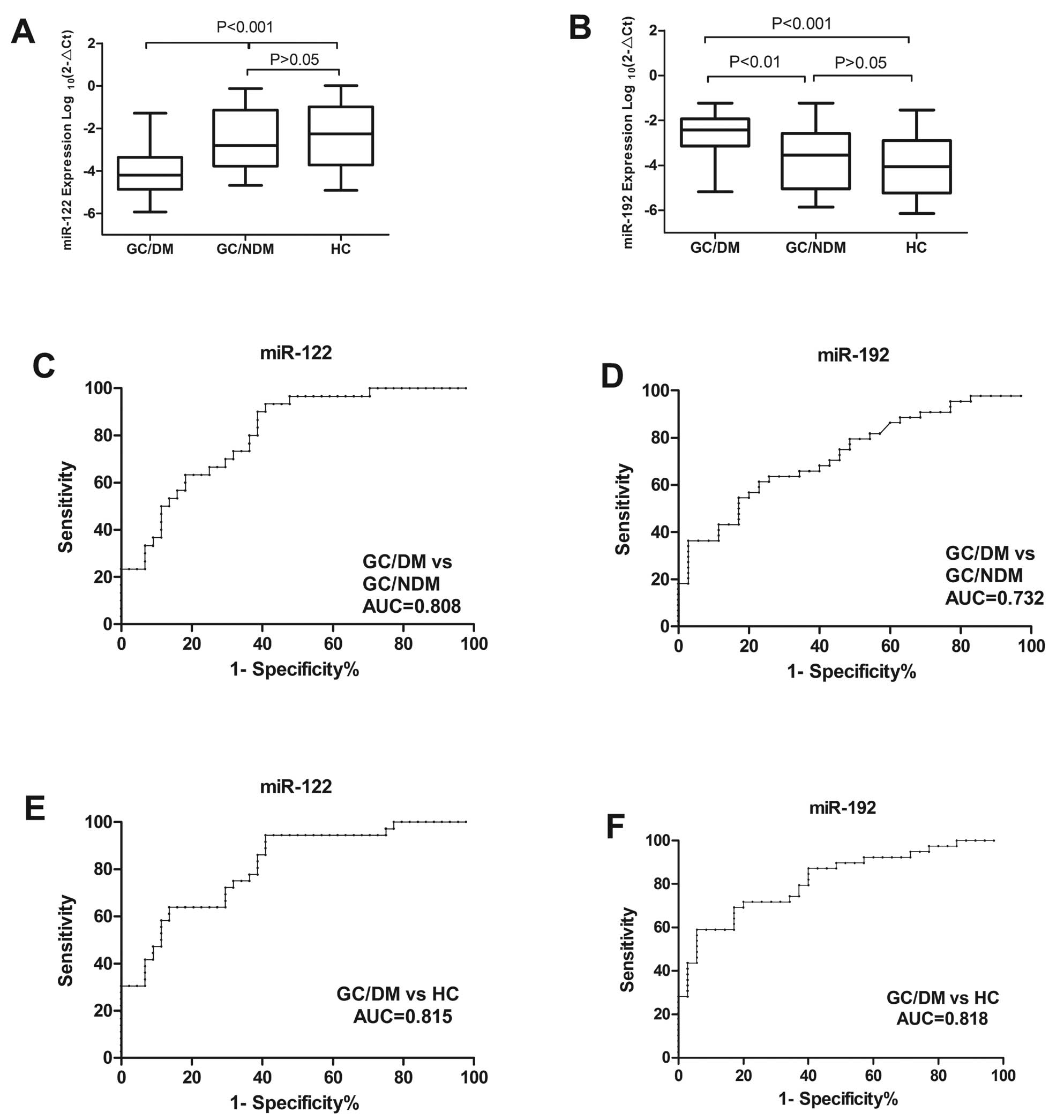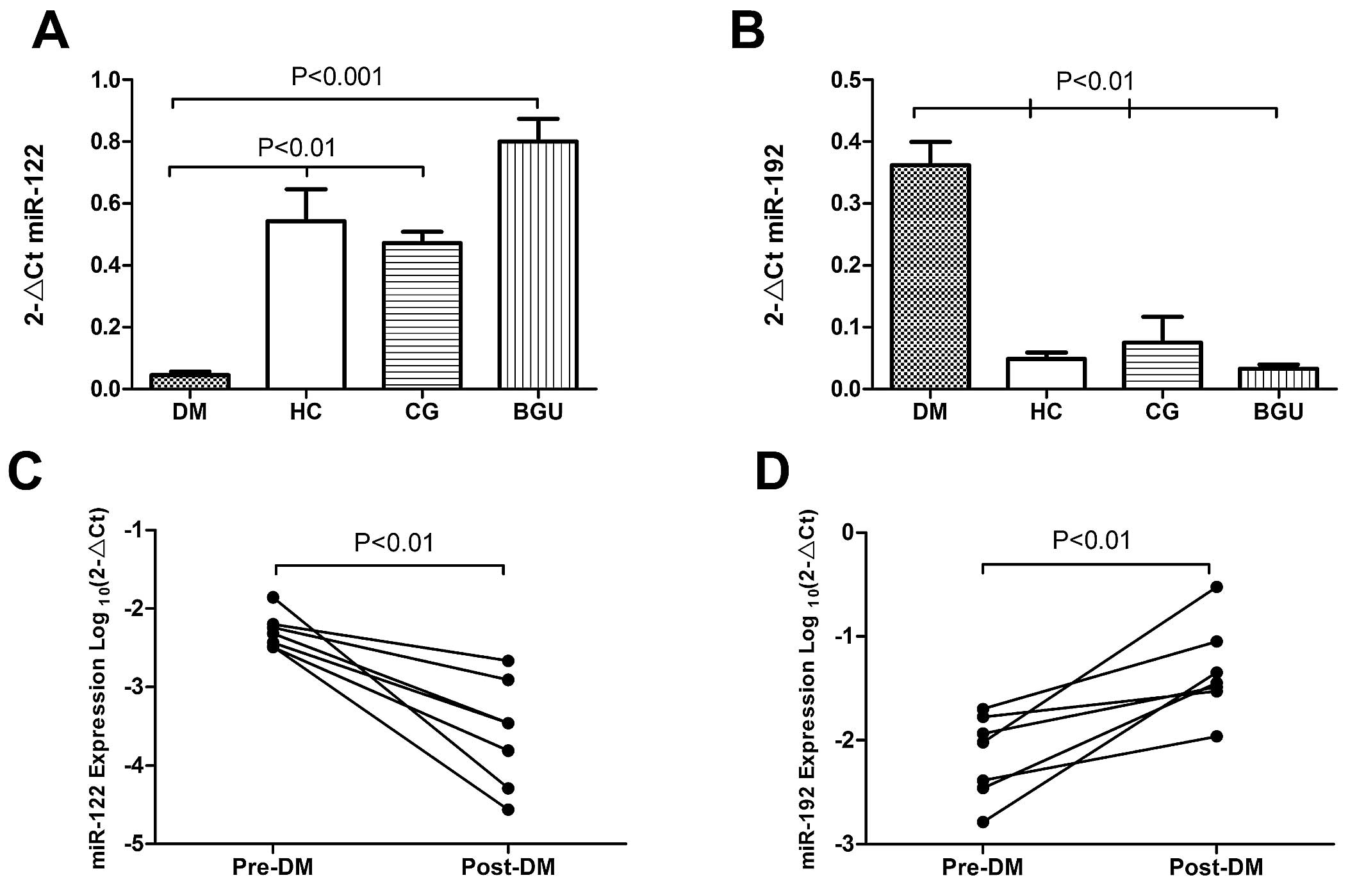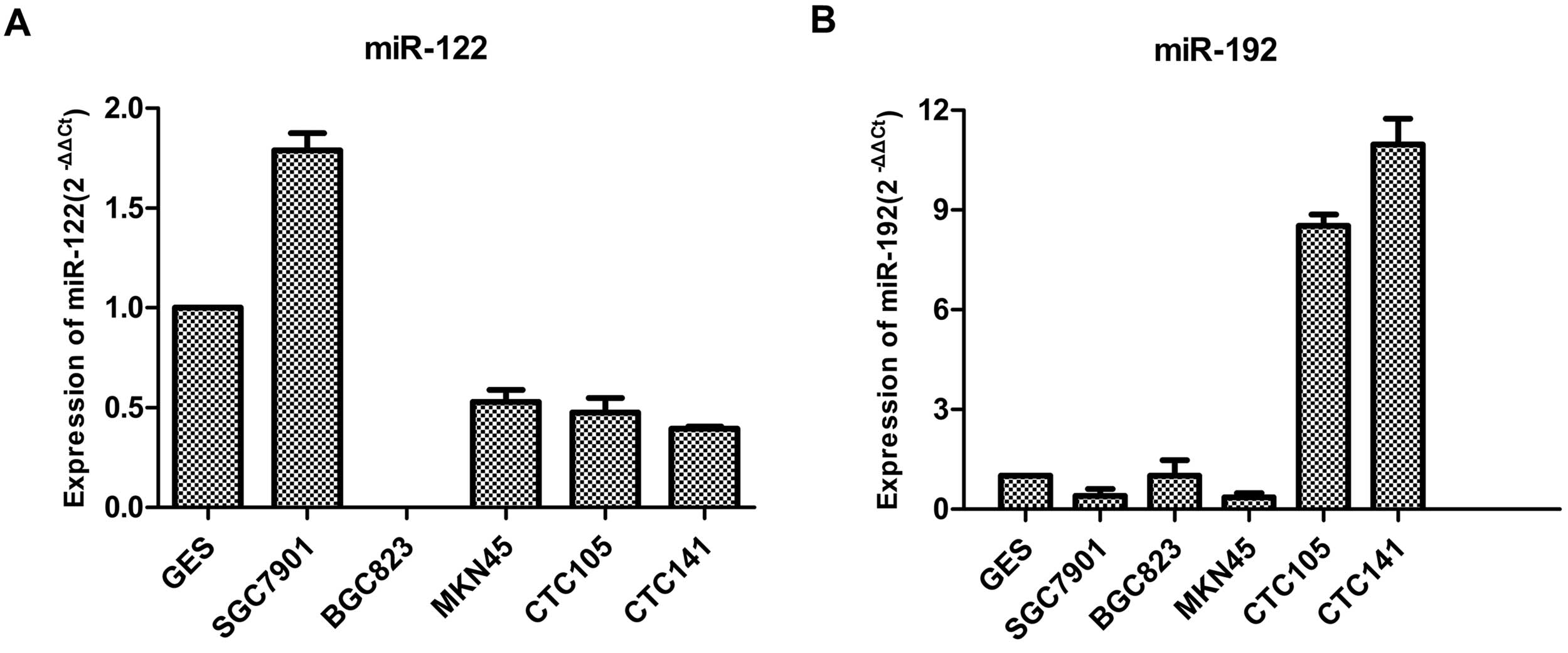|
1
|
Jemal A, Siegel R, Xu J and Ward E: Cancer
statistics, 2010. CA Cancer J Clin. 60:277–300. 2010. View Article : Google Scholar
|
|
2
|
Ferlay J, Shin HR, Bray F, Forman D,
Mathers C and Parkin DM: Estimates of worldwide burden of cancer in
2008: GLOBOCAN 2008. Int J Cancer. 127:2893–2917. 2010. View Article : Google Scholar : PubMed/NCBI
|
|
3
|
Jemal A, Bray F, Center MM, Ferlay J, Ward
E and Forman D: Global cancer statistics. CA Cancer J Clin.
61:69–90. 2011. View Article : Google Scholar
|
|
4
|
Yang L: Incidence and mortality of gastric
cancer in China. World J Gastroenterol. 12:17–20. 2006.
|
|
5
|
Schlansky B and Sonnenberg A: Epidemiology
of noncardia gastric adenocarcinoma in the United States. Am J
Gastroenterol. 106:1978–1985. 2011. View Article : Google Scholar : PubMed/NCBI
|
|
6
|
Kamangar F, Dores GM and Anderson WF:
Patterns of cancer incidence, mortality, and prevalence across five
continents: defining priorities to reduce cancer disparities in
different geographic regions of the world. J Clin Oncol.
24:2137–2150. 2006. View Article : Google Scholar
|
|
7
|
Glimelius B, Ekström K, Hoffman K, et al:
Randomized comparison between chemotherapy plus best supportive
care with best supportive care in advanced gastric cancer. Ann
Oncol. 8:163–168. 1997. View Article : Google Scholar : PubMed/NCBI
|
|
8
|
Murad AM, Santiago FF, Petroianu A, Rocha
PR, Rodrigues MA and Rausch M: Modified therapy with
5-fluorouracil, doxorubicin, and methotrexate in advanced gastric
cancer. Cancer. 72:37–41. 1993. View Article : Google Scholar : PubMed/NCBI
|
|
9
|
Pyrhonen S, Kuitunen T, Nyandoto P and
Kouri M: Randomised comparison of fluorouracil, epidoxorubicin and
methotrexate (FEMTX) plus supportive care with supportive care
alone in patients with non-resectable gastric cancer. Br J Cancer.
71:587–591. 1995. View Article : Google Scholar : PubMed/NCBI
|
|
10
|
Van Cutsem E, Moiseyenko VM, Tjulandin S,
et al: Phase III study of docetaxel and cisplatin plus fluorouracil
compared with cisplatin and fluorouracil as first-line therapy for
advanced gastric cancer: a report of the V325 Study Group. J Clin
Oncol. 24:4991–4997. 2006.PubMed/NCBI
|
|
11
|
Roth AD, Fazio N, Stupp R, et al:
Docetaxel, cisplatin, and fluorouracil; docetaxel and cisplatin;
and epirubicin, cisplatin, and fluorouracil as systemic treatment
for advanced gastric carcinoma: a randomized phase II trial of the
Swiss Group for Clinical Cancer Research. J Clin Oncol.
25:3217–3223. 2007. View Article : Google Scholar
|
|
12
|
Chang YR, Han DS, Kong SH, et al: The
value of palliative gastrectomy in gastric cancer with distant
metastasis. Ann Surg Oncol. 19:1231–1239. 2012. View Article : Google Scholar : PubMed/NCBI
|
|
13
|
Li C, Yan M and Zhu ZG: Nonpalliative
surgical resection for gastric cancer patients with distant
metastasis. J Invest Surg. 25:100–106. 2012. View Article : Google Scholar : PubMed/NCBI
|
|
14
|
Bartel DP: MicroRNAs: genomics,
biogenesis, mechanism, and function. Cell. 116:281–297. 2004.
View Article : Google Scholar : PubMed/NCBI
|
|
15
|
Calin GA and Croce CM: MicroRNA signatures
in human cancers. Nat Rev Cancer. 6:857–866. 2006. View Article : Google Scholar : PubMed/NCBI
|
|
16
|
Ambros V: The functions of animal
microRNAs. Nature. 431:350–355. 2004. View Article : Google Scholar : PubMed/NCBI
|
|
17
|
Garzon R, Calin GA and Croce CM: MicroRNAs
in cancer. Annu Rev Med. 60:167–179. 2009. View Article : Google Scholar
|
|
18
|
Ortholan C, Puissegur MP, Ilie M, Barbry
P, Mari B and Hofman P: MicroRNAs and lung cancer: new oncogenes
and tumor suppressors, new prognostic factors and potential
therapeutic targets. Curr Med Chem. 16:1047–1061. 2009. View Article : Google Scholar : PubMed/NCBI
|
|
19
|
Shen J, Stass SA and Jiang F: MicroRNAs as
potential biomarkers in human solid tumors. Cancer Lett.
329:125–136. 2012. View Article : Google Scholar
|
|
20
|
Allegra A, Alonci A, Campo S, et al:
Circulating microRNAs: new biomarkers in diagnosis, prognosis and
treatment of cancer (Review). Int J Oncol. 41:1897–1912.
2012.PubMed/NCBI
|
|
21
|
Blanco-Calvo M, Calvo L, Figueroa A,
Haz-Conde M, Antón-Aparicio L and Valladares-Ayerbes M: Circulating
microRNAs: molecular microsensors in gastrointestinal cancer.
Sensors. 12:9349–9362. 2012. View Article : Google Scholar : PubMed/NCBI
|
|
22
|
Song MY, Pan KF, Su HJ, et al:
Identification of serum microRNAs as novel non-invasive biomarkers
for early detection of gastric cancer. PLoS One. 7:e336082012.
View Article : Google Scholar : PubMed/NCBI
|
|
23
|
Wang M, Gu H, Wang S, et al: Circulating
miR-17-5p and miR-20a: molecular markers for gastric cancer. Mol
Med Rep. 5:1514–1520. 2012.PubMed/NCBI
|
|
24
|
Chen T, Yang K, Yu J, et al:
Identification and expansion of cancer stem cells in tumor tissues
and peripheral blood derived from gastric adenocarcinoma patients.
Cell Res. 22:248–258. 2012. View Article : Google Scholar : PubMed/NCBI
|
|
25
|
Liu R, Zhang C, Hu Z, et al: A
five-microRNA signature identified from genome-wide serum microRNA
expression profiling serves as a fingerprint for gastric cancer
diagnosis. Eur J Cancer. 47:784–791. 2011. View Article : Google Scholar : PubMed/NCBI
|
|
26
|
Hu Z, Dong J, Wang LE, et al: Serum
microRNA profiling and breast cancer risk: the use of miR-484/191
as endogenous controls. Carcinogenesis. 33:828–834. 2012.
View Article : Google Scholar : PubMed/NCBI
|
|
27
|
Takei Y, Takigahira M, Mihara K, Tarumi Y
and Yanagihara K: The metastasis-associated microRNA miR-516a-3p is
a novel therapeutic target for inhibiting peritoneal dissemination
of human scirrhous gastric cancer. Cancer Res. 71:1442–1453. 2011.
View Article : Google Scholar
|
|
28
|
Gui J, Tian Y, Wen X, et al: Serum
microRNA characterization identifies miR-885-5p as a potential
marker for detecting liver pathologies. Clin Sci. 120:183–193.
2011. View Article : Google Scholar : PubMed/NCBI
|
|
29
|
Hurst DR, Edmonds MD and Welch DR:
Metastamir: the field of metastasis-regulatory microRNA is
spreading. Cancer Res. 69:7495–7498. 2009. View Article : Google Scholar : PubMed/NCBI
|
|
30
|
Hur K, Toiyama Y, Takahashi M, et al:
MicroRNA-200c modulates epithelial-to-mesenchymal transition (EMT)
in human colorectal cancer metastasis. Gut. 62:1315–1326. 2012.
View Article : Google Scholar : PubMed/NCBI
|
|
31
|
Valastyan S, Reinhardt F, Benaich N, et
al: A pleiotropically acting microRNA, miR-31, inhibits breast
cancer metastasis. Cell. 137:1032–1046. 2009. View Article : Google Scholar : PubMed/NCBI
|
|
32
|
Jopling C, Norman K and Sarnow P: Positive
and negative modulation of viral and cellular mRNAs by
liver-specific microRNA miR-122. Cold Spring Harbor Symposia on
Quantitative Biology. Cold Spring Harbor Laboratory Press; pp.
369–376. 2006, View Article : Google Scholar : PubMed/NCBI
|
|
33
|
Etiemble J, Möröy T, Jacquemin E, Tiollais
P and Buendia M: Fused transcripts of c-myc and a new cellular
locus, hcr in a primary liver tumor. Oncogene. 4:51–57.
1989.PubMed/NCBI
|
|
34
|
Girard M, Jacquemin E, Munnich A, Lyonnet
S and Henrion-Caude A: miR-122, a paradigm for the role of
microRNAs in the liver. J Hepatol. 48:648–656. 2008. View Article : Google Scholar : PubMed/NCBI
|
|
35
|
Wu X, Somlo G, Yu Y, et al: De novo
sequencing of circulating miRNAs identifies novel markers
predicting clinical outcome of locally advanced breast cancer. J
Transl Med. 10:422012. View Article : Google Scholar
|
|
36
|
Iino I, Kikuchi H, Miyazaki S, et al:
Effect of miR-122 and its target gene cationic amino acid
transporter 1 on colorectal liver metastasis. Cancer Sci.
104:624–630. 2013. View Article : Google Scholar : PubMed/NCBI
|
|
37
|
Tsai WC, Hsu PWC, Lai TC, et al:
MicroRNA-122, a tumor suppressor microRNA that regulates
intrahepatic metastasis of hepatocellular carcinoma. Hepatology.
49:1571–1582. 2009. View Article : Google Scholar : PubMed/NCBI
|
|
38
|
Hsu SH, Wang B, Kota J, et al: Essential
metabolic, anti-inflammatory, and anti-tumorigenic functions of
miR-122 in liver. J Clin Invest. 122:2871–2883. 2012. View Article : Google Scholar : PubMed/NCBI
|
|
39
|
Gu J, Wang Y and Wu X: MicroRNA in the
pathogenesis and prognosis of esophageal cancer. Curr Pharm Des.
19:1292–1300. 2013.PubMed/NCBI
|
|
40
|
Zhao C, Zhang J, Zhang S, et al:
Diagnostic and biological significance of microRNA-192 in
pancreatic ductal adenocarcinoma. Oncol Rep. 30:276–284.
2013.PubMed/NCBI
|
|
41
|
Schee K, Lorenz S, Worren MM, et al: Deep
sequencing the MicroRNA transcriptome in colorectal cancer. PLoS
One. 8:e661652013. View Article : Google Scholar : PubMed/NCBI
|
|
42
|
Chiang Y, Song Y, Wang Z, et al:
microRNA-192, -194 and -215 are frequently downregulated in
colorectal cancer. Exp Ther Med. 3:560–566. 2012.PubMed/NCBI
|
|
43
|
Wang G, Chan ES, Kwan BC, et al:
Expression of microRNAs in the urine of patients with bladder
cancer. Clin Genitourin Cancer. 10:106–113. 2012. View Article : Google Scholar : PubMed/NCBI
|
|
44
|
Kim T, Veronese A, Pichiorri F, et al: p53
regulates epithelial–mesenchymal transition through microRNAs
targeting ZEB1 and ZEB2. J Exp Med. 208:875–883. 2011.
|
|
45
|
Chiang Y, Zhou X, Wang Z, et al:
Expression levels of microRNA-192 and -215 in gastric carcinoma.
Pathol Oncol Res. 18:585–591. 2012. View Article : Google Scholar : PubMed/NCBI
|


















